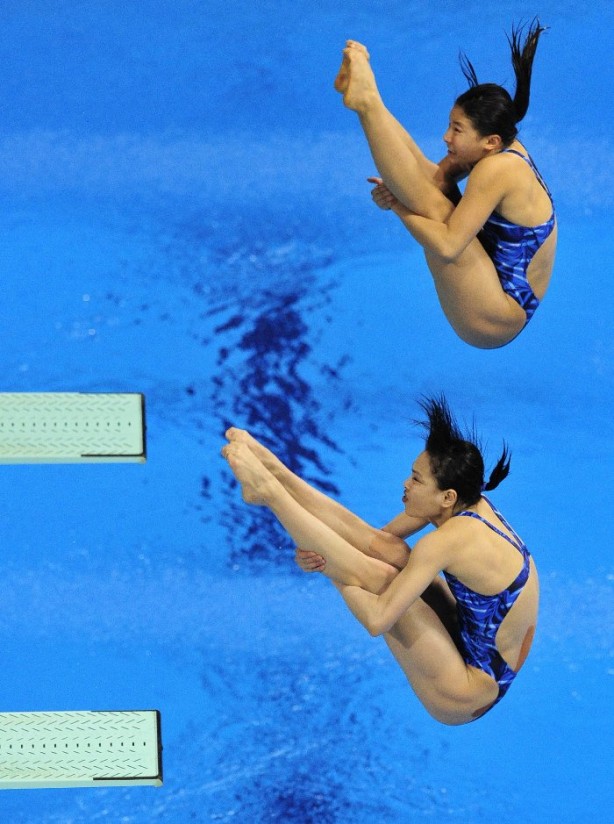 |
| Chinese Olympic Synchronized Divers |
Within the last
week fans around the world have been dazzled by the 2012 Summer Olympics in
London, England. Unlike professional sports, Olympians work hard and
train relentlessly for the euphoric, yet hypothetical moment when they might be
named the top athlete of their sport in the world. Professional sports
and Olympic athletic events often clash in that many professional leagues do
not allow all of their athletes to compete in the Olympic games. Overall, most
fans watch the Olympics for those sports that are rarely spoken of in common
sports vernacular. One of those sports with which I have become enamored
is synchronized diving. Synchronized diving?!! Yes, yes, I'm
speaking of the sport in which a pair of men or women, propel themselves,
sometimes from extreme heights, contort themselves, and perform flips in
mid-air before they comfortably land in the water. Oh, and by the way,
the two athletes are supposed to perform the same dive at exactly the same
time. A perfect dive is not only executed well, but should appear as
though one diver is performing the feat in a mirror.
Judges base their
scores on execution and synchronization. This caused me to wonder if
there were any similarities between synchronized diving and baseball. Not
long after posing this question to myself I found the answer. The double
play. Double plays, like many defensive plays in baseball, involve two
key attributes, physical ability and baseball intelligence.
| The 6-4-3 Variety |
Double plays
constitute some of the most beautiful and elegant plays in the game of
baseball. Double plays occur quite often, in fact, pitchers will change
their strategies when a runner is on-base in order to induce a ground ball to
result in a twin killing. Double plays, like jeans, come in all shapes
and sizes. Common double plays include the 6-4-3, the 4-6-3, the 5-4-3, and the 3-6-3. The most
commonly involved players are the shortstop, second baseman, and first baseman.
Double plays, unlike most other defensive plays in baseball, involve a
tandem of players who must prepare mentally and strategically, and then work
together to physically carry out their intended task.
Just like the
judges in an Olympic synchronized diving competition, we often grade the
participants of a double play in two categories, mental preparation and
execution. In addition, the execution of an Olympic dive is partially
graded based upon the difficulty of the dive. This concept also applies
to the double play. Not all double plays are created equal. Most
baseball aficionados would consider a conventional double play one where
a ground ball is hit directly at the shortstop.
He fields it cleanly, throwing the ball to the second baseman who has
already occupied second base. The second
baseman catches the ball before the runner slides into the base, and throws a
strike to the first baseman, thus achieving two outs in one play.
There is no way
around it—double plays are a defensive goal and devastating to the
offense. This season, the team that has collectively grounded into the
most double plays is the Minnesota Twins. Not surprisingly the Twins also
lead the major leagues in ground balls hit. The Twins play in a
pitcher/defense-oriented park, don't have a great offense, and have a number of
fast players who would consistently hit the ball on the ground.
How about the
other side? I could not find a website that tracked the team that caused
the most double play situations, but in lieu of that the baseball world uses a
pitcher's ground ball percentage. The pitcher with the highest GB%
this season with a minimum of 70 innings pitched is Arizona Diamondbacks right-hander
Trevor Cahill with a 61% ground ball percentage. The team with the
highest ground ball percentage thus far in 2012 is the St. Louis Cardinals at
48.9%. More double plays have occurred this season in the 6th inning than
any other, while the fewest double plays have occurred in the 9th inning.
In addition, more double plays occurred in high leverage situations than
any other. Finally, pitchers created the most double plays this season in
a no-ball one-strike count.
Sometimes double
plays are quite odd. This 4-2-1 double play occurred in a game between
the Red Sox and the Rays in 2010 (Video). Not all double plays involve only infielders.
For example, an outfielder may catch a fly ball, and consequently throw
out a runner attempting to tag up. Check out Rick Ankiel catching a fly
ball in center field and throwing out a runner at third base, completing the
8-5 double play (Video). Like many of the Olympic events, including
synchronized diving, double plays often require athletic prowess. In
order to avoid a base runner sliding into them, and thus breaking up the double
play, shortstops will often jump over the incoming runner and
throw simultaneously to first base.
| Gold Glove |
| Gold Medal |
Double plays are
a huge part of a baseball game. Sometimes they go around-the-horn
(5-4-3), while other times they move all over the infield, as in my favorite
double play, the 1-2-3 variety. The ability to complete a double play
will often change the strategy of one or both of the managers. Certain
pitchers with abilities to produce ground balls are called upon in situations
when a double play is likely to occur. Overall, one thing is certain: the
ability to get two outs in one play is invaluable. It is comparable to
going to the grocery store to buy laundry detergent and seeing that there is a
buy-one-get-one free sale. In sum, double plays are elegant, difficult to
execute, and require team coordination, attributes that make the double play
oddly similar to a synchronized dive. Although the fielders do not win
gold medals, double plays do help them win gold gloves.
No comments:
Post a Comment